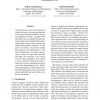163 search results - page 20 / 33 » Use of Lexicon Density in Evaluating Word Recognizers |
114
click to vote
PRL
2007
14 years 10 months ago
2007
This paper introduces a novel method of visual learning based on Genetic Programming, which evolves a population of individuals (image analysis programs) that process attributed v...
EUROGP
2010
Springer
15 years 3 months ago
2010
Springer
We describe a data mining framework that derives panelist information from sparse flavour survey data. One component of the framework executes genetic programming ensemble based s...
NAACL
2007
15 years 4 hour ago
2007
Graph-based semi-supervised learning has recently emerged as a promising approach to data-sparse learning problems in natural language processing. All graph-based algorithms rely ...
ASPLOS
1989
ACM
15 years 2 months ago
1989
ACM
A very long instruction word (VLIW) processorexploits parallelism by controlling multiple operations in a single instruction word. This paper describes the architecture and compil...
EMNLP
2008
15 years 21 hour ago
2008
Human linguistic annotation is crucial for many natural language processing tasks but can be expensive and time-consuming. We explore the use of Amazon's Mechanical Turk syst...

